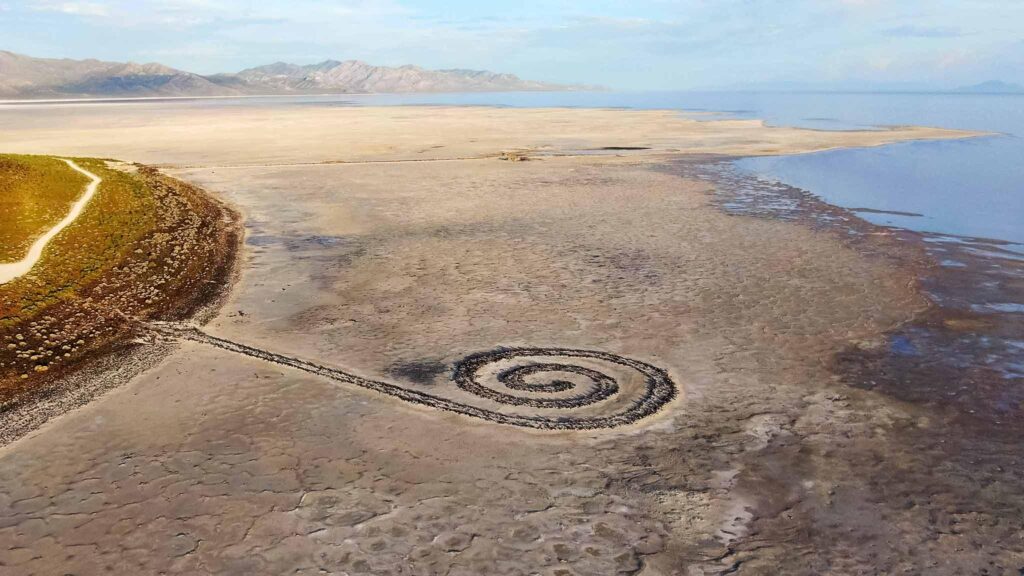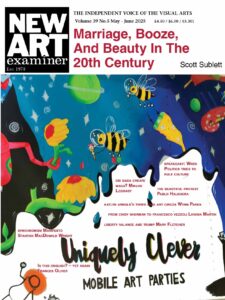
Spiral Jetty
| unsignificantly off the coast there wasa splash quite unnoticed this was Icarus drowning (William Carlos Williams, from Landscape With the Fall of Icarus) |
The presence of an abandoned pier and oil rigs on the way to the gravel parking lot renders the sudden starkness of the sight all the more striking. Strangely – or perhaps not – my first view of Spiral Jetty reminded me of my first view of Venice.
It’s just like it looks in pictures, I thought, but to be in its presence is overwhelming.

In the constructed sense, a jetty is, by definition, a structure thrown into an expanse, as Smithson’s jetty is thrown, spiraling, into the Great Salt Lake. Which, as I write this, has now retreated from it. After being submerged for some 30 years, the jetty spirals out into the sand, 1500 feet long, 15 feet wide, stretching toward the lake itself but no longer into it. It remains curled, labyrinthine, a counterclockwise contraction of mud, salt crystals and basalt. A mystery in full view. But a mystery.
South of the Salt Lake City Lance Olsen has created spirals of his own. A writer and professor at the University of Utah, whose work I discovered, we could say, circuitously. In ‘there’s no place like time’, a faux retrospective exhibition catalog of the work of (fictional) video artist Alana Olsen, Olsen (writing as the also fictional Aila Olsen) discusses a video essay by Alana Olsen about Spiral Jetty (the video actually created by Olsen’s wife, the artist Andi Olsen). He describes the spiral as “cousin to the labyrinth,” noting its ubiquity in nature – hurricanes, pinecones, fingerprints, nautilus shells.
A chapter of Bachelard’s The Poetics of Space is devoted to the spiral form of the shell. “They are privileged forms that are more intelligible for the eye though more mysterious for the mind,” he quotes Paul Valery. The shell, Bachelard suggests, is a form of contradiction linked to protection and refuge as well as emergence and vulnerability. An exterior roughness and durete encloses an interior softness. Allegory and symbol of resurrection, renewal and reawakening – as Olsen notes, “a journey from this plane to the next, outside to inside.” Near the end of the chapter, Bachelard describes Bernard Palissy’s “fortress city,” a city structured, for defensive purposes, around a central “open square”:
Starting from this square, a single street would run four times around the square; first, in two circuits that espoused the shape of the square; then, in two octagon-shaped circuits. All doors and windows in this quadruple winding street were to give on to the inside of the fortress, so that the backs of the houses would constitute one continuous wall. The last of the house-walls was to back up against the city wall which, thus, would form a gigantic snail. So what is being defended against and what protected, in Olsen’s parable, or Bachelard’s? A “synthesis of house, shell and rock” the fortress city would become for the invader a “tortuous labyrinth,” an ever-unfolding exterior wrapped around an open, empty interior. The protection the spiral would seem to provide is a protection of confusion – interior for exterior, concealment for revelation, contraction for expansion, coiling for throwing.
This movement, this dynamic of expand-contract, conceal-reveal, inside-outside, represents, perhaps more than anything else, the structure of a dream. In House of Leaves, Mark Danielewski demonstrates this tension by showing us dreams’ power to unravel the spiral that Bachelard has laid out for us. Yet he describes Bachelard’s spiral as an inversion of his own. Who is unravelling whom? In chapter XVII (“Reasons”) of House of Leaves, the protagonist, Will Navidson has a dream in which he: ‘… finds himself in the centre of a strange town where some sort of feast is in progress. The smell of garlic and beer haunts the air. Everyone is eating and drinking and Navidson understands that for some undisclosed reason they will now have enough food to last for many decades. When the feast finally comes to an end, everyone grabs a candle and begins to march out of the town. Navidson follows and soon discovers that they are heading for a hill on which lies the shell of an immense snail.’
In the analysis of the character’s dream, Bachelard’s work is described as a “remarkable” inversion of the endless spiral staircase in the inconceivable labyrinth that is the Navidson home on Ash Tree Lane, the house of leaves. The endless expanding interior of Navidson’s impossible, uncanny house, far from being a place of refuge, becomes a place of vulnerability into which Will Navidson is thrown – or throws himself. For there is a “thrownness” in dreams as well, these strange narratives and worlds in which we find ourselves in sleep’s darkness. We seem to have been thrown into them – but we ourselves are the thrower. Similarly, any dream relies on “remarkable inversions” and confusions as (unconscious) interior concealment is thrown toward the (exterior) revelation of the dream’s manifest content. Rather than the symmetry of the snail shell (and spiral form), the house (or the dream) only offers an endless, labyrinthine thrownness.
Louise Bourgeois embraces thrownness not as a chaotic vortex, but as a paradox, a paradox made personal, in which tension is both portrayed and dispersed. Indeed, critical analysis of her work is often linked back to her personal history and psychology, her relations to her mother and feelings toward her philandering father. These biographical echoes reverberate as Bourgeois herself often remarks on the paradox of the spiral. It’s an ‘… attempt at controlling the chaos. It has two directions. Where do you place yourself, at the periphery or at the vortex? Beginning at the outside is the fear of losing control; the winding in is a tightening, a repeating, a compacting to the point of disappearance. Beginning at the center is affirmation, the move outward is a representation of giving, and giving up control . . . Spirals – which way to turn – represent the fragility in an open space.’ Or, put another way, are you thrown or still? Does the spiral enclose or open? As in Palissy’s fortress city, are we sensing interior or exterior?
The confusions of the labyrinth, the spiral, may be spatial or psychological, external or internal, but, like a dream, it condenses and displaces. And at its center, a navel, that obscure place – as Freud writes – “the tangle . . . which cannot be unraveled . . . the spot where it reaches down into the unknown.” In the end, any comfort the spiral gives us appears in the form of a question mark, the quintessential spiral. An unsettling form of comfort indeed. It gives us a map leading both in and out, but from where? To where? La jetee, Marker’s haunting meditation on thrownness, spirals in on itself also, as the protagonist realizes – in the most nightmarish revelation imaginable – that the “moment he had been granted to watch as a child, which had never ceased to obsess him, was the moment of his own death,” the void, the navel of every spiral…the emptiness that sits at the center of every labyrinth.
But is the center really empty, or void? I imagine a day three years after the creation of Spiral Jetty. The sky over Amarillo, Texas is bright, opalescent as a salt flat on July 20, 1973 as Robert Smithson is thrown from a plane, like Icarus, spiraling to earth. Unlike Icarus, but like Spiral Jetty now, there is no water, no splash, no drowning, only wasteland and the end, or the beginning, of the world. *
the edge of the sea
concerned
with itself
sweating in the sun
that melted
the wings’ wax
(William Carlos Williams, from Landscape With the Fall of Icarus)
Steve Harp
_______________________________________
Landscape with the Fall of Icarus, after the Breugel painting of the same name is a poem by William Carlos Williams, published in 1960 and subsequently reprinted in Pictures From Breugel and Other Poems in 1962 (the same year La jetee premiered). In a dream-like but all too real condensation, William Carlos Williams was Robert Smithson’s childhood pediatrician.


I have yet to experience THIS!…..I always dreamed of seeing Every Earthwork. I do not feel it is too late for me. In all my travels I made happen. … Never have I been to every Place I NEED and Want to see. to stand in. To smell. Closed eyes….Breath. Breath IN… to FEEL.
For those of you whom have had the pleasure and Spiritual Luxury of the Spiral Jetty!?…
Please tell me why THIS is Not WORTH knowing?
Thank you in advance for your thoughts.
Renee Gory
[spoiler title=” “]
I love you Renee❤️
MY Richie…. that is mutual. I can’t thank you enough for coming into my life, because can you help me reinvent it!!! And you taught me more than you think, because I paid attention and you’re a lot smarter than you think, because you’re damn well, are.
Thanks for being one of the best friends a girl can have. … I recently found out that Derek Guthrie my mentor, FOUNDON FATHER OF THIS VERY MAGAZINE
THAT STARTED IN CHICAGO with his beloved wife Jane… He has passed and I miss him every day, but I do exactly what he did, has he instructed me to live ” WITHOUT FEAR OR FAVOR” !!! And to never pass up a good conversation at a local coffee shop. … It makes me think of the painting nighthawks. … until we talk again much respect back to you Buddy Boy!!!
MY Richie…. that is mutual. I can’t thank you enough for coming into my life, because can you help me reinvent it!!! And you taught me more than you think, because I paid attention and you’re a lot smarter than you think, because you’re damn well, are.
Thanks for being one of the best friends a girl can have. … I recently found out that Derek Guthrie my mentor, FOUNDON FATHER OF THIS VERY MAGAZINE
THAT STARTED IN CHICAGO with his beloved wife Jane… He has passed and I miss him every day, but I do exactly what he did, has he instructed me to live ” WITHOUT FEAR OR FAVOR” !!! And to never pass up a good conversation at a local coffee shop. … It makes me think of the painting nighthawks. … until we talk again much respect back to you Buddy Boy!!!